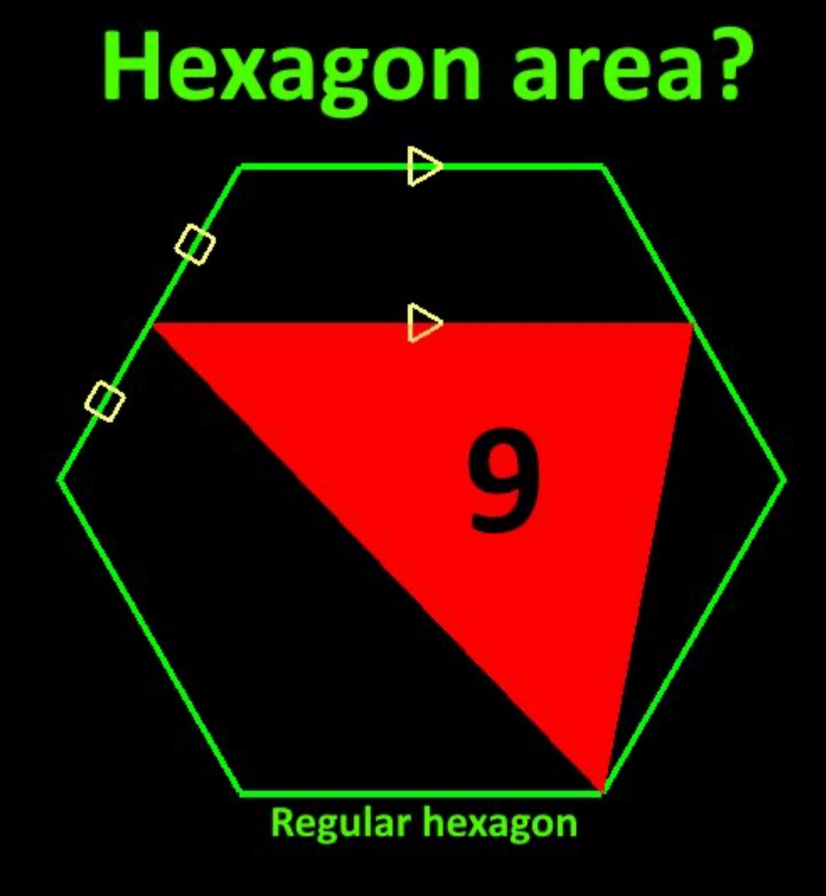Question Number 193908 by Rupesh123 last updated on 22/Jun/23

Answered by Subhi last updated on 22/Jun/23
![put each side = l BH = AG = (l/2) GA^� K=MB^� H=120−90=30 HM = GK = (l/4) (opposite to angle 30 in a right triangle) GH = l+(1/2)l=(3/2)l in Δ GFE: EG=(√(l^2 +(1/4)l^2 −l^2 cos(120))) = ((√7)/2)l (cos law) (((√7)l)/(2sin(120)))=(l/(sin(x))) ⇛ x = sin^(−1) (((√(21))/7))=40.89 AB//GH ⇛ EG^� H = A^� = 120 EG^� H = 120−x = 79.1 9=[RGH]=(1/2).((√7)/2).(3/2)l^2 .sin(79.1) l = 3.039 Area of regular hexagon = ((3(√3))/2)l^2 =24](https://www.tinkutara.com/question/Q193911.png)
$${put}\:{each}\:{side}\:=\:{l} \\ $$$${BH}\:=\:{AG}\:=\:\frac{{l}}{\mathrm{2}} \\ $$$${G}\hat {{A}K}={M}\hat {{B}H}=\mathrm{120}−\mathrm{90}=\mathrm{30} \\ $$$${HM}\:=\:{GK}\:=\:\frac{{l}}{\mathrm{4}}\:\left({opposite}\:{to}\:{angle}\:\mathrm{30}\:{in}\:{a}\:{right}\:{triangle}\right) \\ $$$${GH}\:=\:{l}+\frac{\mathrm{1}}{\mathrm{2}}{l}=\frac{\mathrm{3}}{\mathrm{2}}{l} \\ $$$${in}\:\Delta\:{GFE}: \\ $$$${EG}=\sqrt{{l}^{\mathrm{2}} +\frac{\mathrm{1}}{\mathrm{4}}{l}^{\mathrm{2}} −{l}^{\mathrm{2}} {cos}\left(\mathrm{120}\right)}\:=\:\frac{\sqrt{\mathrm{7}}}{\mathrm{2}}{l}\:\left({cos}\:{law}\right) \\ $$$$\frac{\sqrt{\mathrm{7}}{l}}{\mathrm{2}{sin}\left(\mathrm{120}\right)}=\frac{{l}}{{sin}\left({x}\right)}\:\Rrightarrow\:{x}\:=\:{sin}^{−\mathrm{1}} \left(\frac{\sqrt{\mathrm{21}}}{\mathrm{7}}\right)=\mathrm{40}.\mathrm{89} \\ $$$${AB}//{GH}\:\Rrightarrow\:{E}\hat {{G}H}\:=\:\hat {{A}}\:=\:\mathrm{120} \\ $$$${E}\hat {{G}H}\:=\:\mathrm{120}−{x}\:=\:\mathrm{79}.\mathrm{1} \\ $$$$\mathrm{9}=\left[{RGH}\right]=\frac{\mathrm{1}}{\mathrm{2}}.\frac{\sqrt{\mathrm{7}}}{\mathrm{2}}.\frac{\mathrm{3}}{\mathrm{2}}{l}^{\mathrm{2}} .{sin}\left(\mathrm{79}.\mathrm{1}\right) \\ $$$${l}\:=\:\mathrm{3}.\mathrm{039} \\ $$$${Area}\:{of}\:{regular}\:{hexagon}\:=\:\frac{\mathrm{3}\sqrt{\mathrm{3}}}{\mathrm{2}}{l}^{\mathrm{2}} =\mathrm{24} \\ $$
Commented by Subhi last updated on 22/Jun/23

Commented by Rupesh123 last updated on 22/Jun/23
Nice solution, sir!
Answered by talminator2856792 last updated on 23/Jun/23

$$\:\:\mathrm{hexagon}\:\mathrm{side}\:\mathrm{length}\:{a}:\:\: \\ $$$$\:\:\mathrm{using}\:\mathrm{30},\mathrm{60},\mathrm{90}\:\mathrm{triangle}\:\mathrm{arrive}\:\mathrm{at}: \\ $$$$\:\:\mathrm{9}\:=\:\frac{\mathrm{3}}{\mathrm{4}}\:×\:\frac{\mathrm{2}{a}}{\:\sqrt{\mathrm{3}}}\:×\:\frac{\mathrm{3}{a}}{\mathrm{2}}\:\boldsymbol{\div}\:\mathrm{2} \\ $$$$\:\:{a}^{\mathrm{2}} \:=\:\mathrm{8}\sqrt{\mathrm{3}} \\ $$$$\:\: \\ $$$$\:\:\mathrm{regular}\:\mathrm{hexagon}\:\mathrm{can}\:\mathrm{be}\:\mathrm{split}\:\mathrm{into}\:\mathrm{six}\:\mathrm{equilateral}\:\:\:\:\:\:\: \\ $$$$\:\:\mathrm{triangles}\:\mathrm{all}\:\mathrm{with}\:\mathrm{side}\:\mathrm{lengths}\:\mathrm{equal}\:\mathrm{to}\:{a}.\:\:\: \\ $$$$\:\:\Rightarrow\:\mathrm{6}\left(\frac{{a}×\frac{{a}}{\:\sqrt{\mathrm{3}}}\:}{\mathrm{2}}\right) \\ $$$$\:\:=\:\sqrt{\mathrm{3}}{a}^{\mathrm{2}} \\ $$$$\:\: \\ $$$$\:\:\mathrm{but}\:{a}^{\mathrm{2}} \:\mathrm{is}\:\mathrm{already}\:\mathrm{known}. \\ $$$$\:\:\Rightarrow\:\sqrt{\mathrm{3}}{a}^{\mathrm{2}} \:=\:\sqrt{\mathrm{3}}\left(\mathrm{8}\sqrt{\mathrm{3}}\right) \\ $$$$\:\:=\:\mathrm{24} \\ $$
Commented by Rupesh123 last updated on 23/Jun/23
Perfect ��
